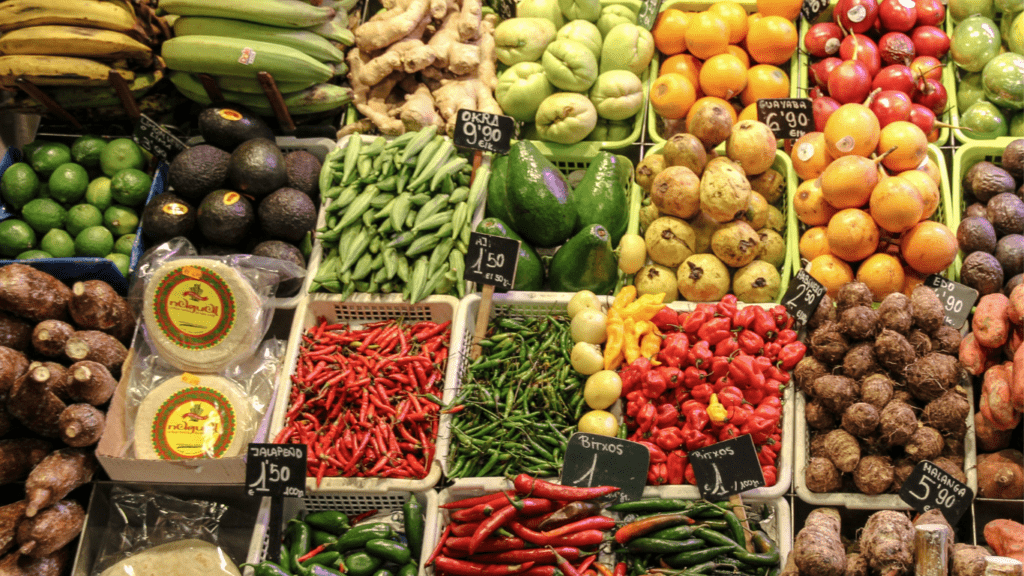Overview of Plant-Based Foods Market
The plant-based foods market is growing rapidly, driven by consumer demand for healthier, sustainable, and ethically produced food options.
According to a report by Grand View Research, the global plant-based meat market reached $5.6 billion in 2020 and is projected to grow at a CAGR of 19.4% from 2021 to 2028. This growth encompasses plant-based versions of meat, dairy, and other traditional animal-based foods.
Major companies like Beyond Meat and Impossible Foods are at the forefront, offering innovative plant-based alternatives. For example, Beyond Meat’s products are available in over 112,000 retail and foodservice outlets globally. This widespread availability showcases the rapid mainstream adoption of plant-based options.
Supermarkets, restaurants, and fast-food chains are expanding their plant-based offerings to meet growing consumer interest. For instance, Burger King introduced the Impossible Whopper in 2019, which quickly became a popular menu item. This shift indicates a significant change in consumer behavior towards plant-based diets.
Plant-based dairy alternatives also show significant growth. The global market for plant-based milk, including almond, soy, and oat milk, was valued at $21.4 billion in 2020, according to Meticulous Research. Increasing lactose intolerance cases and a rising vegan population drive this segment’s expansion.
The plant-based foods market is expanding due to changing consumer preferences and increased awareness of health, environmental, and ethical concerns. Key players continue to innovate, ensuring that the market remains dynamic and competitive.
Key Drivers of the Market Growth
The plant-based food market’s growth is influenced by several key factors. These drivers demonstrate how changing consumer dynamics and advancements in technology shape this rapidly evolving sector.
Health and Wellness Trends
Consumers are increasingly prioritizing health. Studies show that many people now associate plant-based diets with benefits like:
- lower cholesterol
- reduced risk of heart disease
Digital platforms heighten awareness by sharing success stories and nutritional facts. For example, research by the National Institutes of Health links plant-based diets to a 16% reduced risk of cardiovascular diseases.
This changing mindset motivates individuals to replace traditional animal-based products with healthier plant-based alternatives.
Environmental Concerns
Environmental awareness drives market growth. Deforestation, greenhouse gas emissions, and water scarcity prompt consumers to rethink food choices. Producing plant-based foods typically requires fewer resources than animal farming.
The Environmental Working Group reports reducing meat and dairy consumption could decrease an individual’s carbon footprint by up to 50%. These environmental advantages appeal to eco-conscious consumers and encourage the adoption of plant-based diets.
Technological Advancements
Technological innovations pave the way for better plant-based products. Advanced processing techniques enhance texture, flavor, and nutritional content.
Beyond Meat and Impossible Foods use cutting-edge methods to create realistic meat substitutes. For example, Impossible Foods developed heme, a molecule that mimics the taste and texture of meat. These improvements attract even skeptical consumers and expand market appeal.
By addressing health, environmental, and technological factors, the plant-based food market attracts a diverse consumer base and continues its growth trajectory.
Market Segments and Consumer Demographics
Businesses targeting plant-based foods need to understand the market segments and consumer demographics to tailor their offerings effectively.
Regional Analysis
Regional demand for plant-based foods varies due to cultural, economic, and regulatory factors. North America and Europe lead in consumption due to high awareness of health and environmental issues.
According to a 2021 report by Euromonitor International, North America holds a significant market share, driven by the United States’ growing vegan and vegetarian population. Europe follows closely with countries like Germany and the United Kingdom embracing plant-based diets widely.
In contrast, Asia-Pacific shows rapid growth potential, driven by increasing disposable incomes and urbanization, with China and India emerging as key markets due to their large populations and shifting dietary patterns.
Latin America and Africa, although currently smaller markets, exhibit considerable growth potential as health and sustainability trends gain traction.
Age and Lifestyle Factors
Different age groups and lifestyles impact plant-based food consumption. Millennials and Gen Z dominate the market, driven by social media influence and a strong alignment with environmental and ethical values.
Data from a 2020 report by The Good Food Institute shows that 49% of Millennials are choosing plant-based foods regularly. Gen X and Baby Boomers, motivated by health concerns, are also adopting plant-based diets, particularly for heart health and weight management.
Athletes and fitness enthusiasts prefer plant-based proteins for performance and recovery benefits. Busy professionals seek convenient, healthy alternatives, contributing to the popularity of plant-based ready meals and snacks.
Understanding these segments helps businesses tailor their marketing and product development strategies to meet the specific needs and preferences of diverse consumer groups.
Major Players in the Plant-Based Foods Industry

In the booming plant-based foods sector, several key players are shaping the market dynamics. Both established companies and innovative startups are contributing to rapid industry growth.
Established Companies
Established companies dominate the plant-based foods market, leveraging their extensive resources and market presence.
- Beyond Meat: Known for its Beyond Burger, it offers a range of meat alternatives that cater to various consumer needs. By 2021, its valuation exceeded $9 billion.
- Impossible Foods: Famous for its Impossible Burger, it’s known for plant-based ingredients that mimic meat flavors and textures. Its products are available in thousands of restaurants globally.
- Nestlé: Through its Garden Gourmet and Sweet Earth brands, Nestlé offers diverse plant-based options, including burgers and sausages.
- Danone: With its Alpro and Silk brands, Danone dominates the plant-based dairy market. It focuses on soy, almond, and oat-based products.
- Unilever: Utilizing its “The Vegetarian Butcher” brand, Unilever provides various plant-based meats, available in both retail and foodservice sectors.
Emerging Startups
Emerging startups bring innovation and diversity to the plant-based foods market, often targeting niche segments.
- Oatly: Specializing in oat-based milk alternatives, Oatly has expanded its product range to ice creams and yogurts, achieving significant market penetration in Europe and the US.
- Miyoko’s Creamery: Focused on artisanal dairy-free cheeses and butter, Miyoko’s employs traditional cheese-making techniques with plant-based ingredients.
- Ripple Foods: Offers pea protein-based dairy alternatives, including milk and yogurt, aiming for high protein content and minimal environmental impact.
- Good Catch: Provides plant-based seafood options, including fish-free tuna and crab cakes, addressing the growing demand for sustainable seafood.
- New Culture: Uses fermentation technology to produce animal-free dairy products, particularly targeting cheese aficionados.
These major players, both established companies and emerging startups, drive innovation and consumer adoption in the plant-based food industry.
Challenges and Opportunities
The plant-based food market is expanding rapidly, presenting both challenges and opportunities that stakeholders need to navigate.
Supply Chain Constraints
Supply chain constraints impact the availability and cost of plant-based foods. High demand strains production capabilities, especially for key ingredients like soy and peas.
Seasonal variations and climatic changes affect crop yields, disrupting consistent supply. Transporting raw materials involves logistical challenges, including cold storage requirements to maintain product quality.
Regulatory hurdles, such as import-export restrictions and labeling standards, further complicate the supply chain landscape.
Innovations and New Product Developments
Innovations drive growth in the plant-based food sector. Companies invest in R&D to create new products and improve existing ones. Beyond Meat and Impossible Foods innovate with plant-based meats that mimic the taste and texture of animal products.
Dairy alternatives, including almond milk and oat yogurt, gain traction with health-conscious consumers. Startups like Oatly and Miyoko’s Creamery introduce unique plant-based offerings, promoting widespread adoption.
Technological advancements in biotechnology and food science enhance product quality and expand market potential.
Future Outlook
Projections for the plant-based food market show promising growth, driven by consumer demand and technological advancements. By 2027, experts expect the global market to reach $35.4 billion, reflecting increasing interest in sustainable and ethical food sources (Fortune Business Insights). Key players continue to innovate, creating more diverse and appetizing alternatives that attract a broader audience.
Several factors contribute to this positive outlook. First, the rising awareness of health benefits associated with plant-based diets influences consumer choices.
Studies link plant-based foods to lower risks of chronic diseases like heart disease and diabetes (Harvard Health Publishing).
Additionally, environmental sustainability drives many consumers to seek eco-friendly options, as plant-based foods typically have a smaller carbon footprint compared to animal products (University of Oxford study).
Innovations in biotechnology and food science propel the market forward. Techniques like fermentation and cellular agriculture enable the development of new products that closely mimic the taste, texture, and nutritional profile of animal-based foods. For instance, companies use precision fermentation to create dairy alternatives with real dairy proteins but without involving animals.
Investment in plant-based foods also increases, with venture capital firms and major food corporations funding research and development efforts.
This financial support accelerates the pace of innovation and brings novel products to market faster. Startups like Motif FoodWorks and Perfect Day are examples of ventures receiving substantial funding to enhance their product portfolios.
Government policies and regulations play a pivotal role in shaping the market’s future. Policymakers are increasingly implementing guidelines that encourage the consumption of plant-based foods.
For instance, dietary guidelines in several countries now recommend reducing meat intake for better health and environmental outcomes.
The foodservice industry adapts to changing consumer preferences by expanding plant-based menu options. Leading chains like McDonald’s and Starbucks introduce plant-based items, making them more accessible to the mainstream market.
This trend is likely to continue, with more restaurants and cafes adding plant-based alternatives to meet customer demand.
The future of the plant-based food market looks bright, with a combination of consumer awareness, technological innovation, robust investment, supportive policies, and industry adaptation driving sustained growth.



